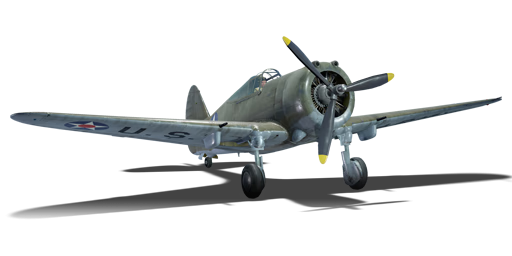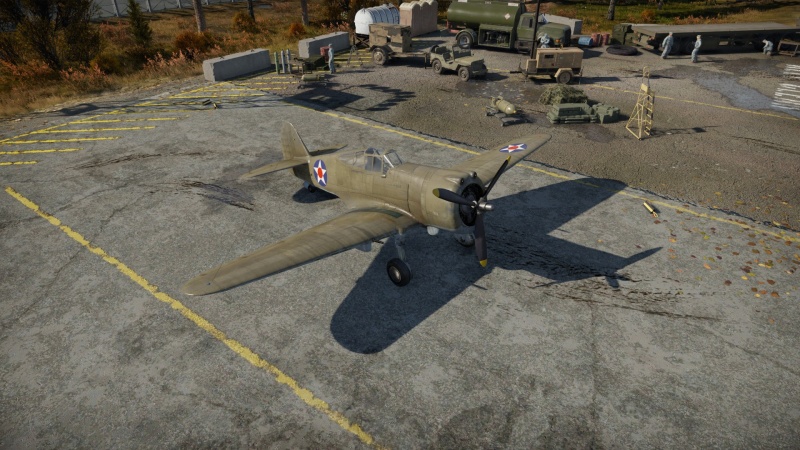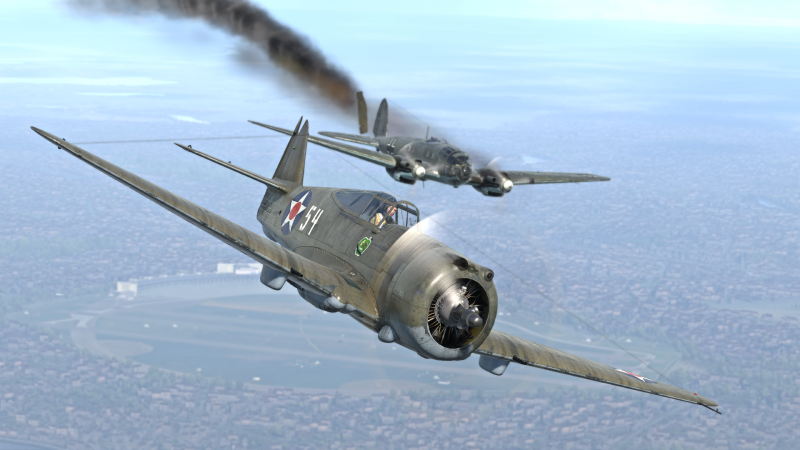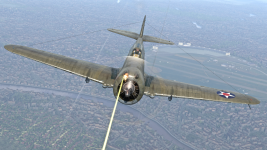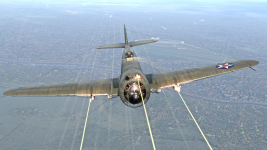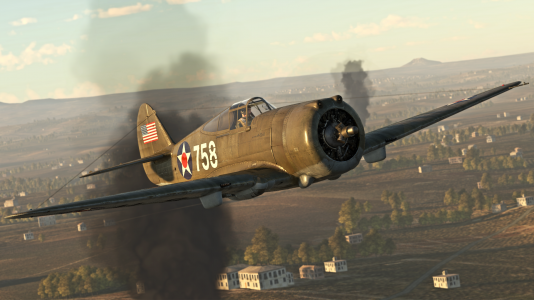Difference between revisions of "P-36C"
(→In-game description: Reformatted) |
m (→Flight performance: RB Turn Time) (Tag: Visual edit) |
||
| (4 intermediate revisions by 4 users not shown) | |||
| Line 6: | Line 6: | ||
{{Specs-Card | {{Specs-Card | ||
|code=p-36c | |code=p-36c | ||
| − | |images={{Specs-Card-Image|GarageImage_{{PAGENAME}}.jpg| | + | |images={{Specs-Card-Image|GarageImage_{{PAGENAME}}.jpg|ArtImage2_{{PAGENAME}}.png}} |
|cockpit=cockpit_p-36c.jpg | |cockpit=cockpit_p-36c.jpg | ||
}} | }} | ||
| Line 40: | Line 40: | ||
|- | |- | ||
! Stock | ! Stock | ||
| − | | | + | | 479 || 464 || rowspan="2" | {{Specs|ceiling}} || 17.7 || 18.2 || 7.1 || 7.1 || rowspan="2" | 183 |
|- | |- | ||
! Upgraded | ! Upgraded | ||
| − | | | + | | 525 || 501 || 16.3 || 17.0 || 15.2 || 10.6 |
|- | |- | ||
|} | |} | ||
| Line 101: | Line 101: | ||
<!-- ''Describe the offensive armament of the aircraft, if any. Describe how effective the cannons and machine guns are in a battle, and also what belts or drums are better to use. If there is no offensive weaponry, delete this subsection.'' --> | <!-- ''Describe the offensive armament of the aircraft, if any. Describe how effective the cannons and machine guns are in a battle, and also what belts or drums are better to use. If there is no offensive weaponry, delete this subsection.'' --> | ||
{{main|M2 Browning (12.7 mm)|Browning (7.62 mm)}} | {{main|M2 Browning (12.7 mm)|Browning (7.62 mm)}} | ||
| + | |||
| + | [[File:Weapon M2 Browning (12.7 mm) P-36C.png|thumb|right|x150px|The 12.7 mm M2 Browning on the right side of P-36C nose.]] | ||
| + | [[File:Weapon Browning (7.62 mm) P-36C.png|thumb|right|x150px|The 7.62 mm Browning on the P-36C wings and nose.]] | ||
The '''''{{PAGENAME}}''''' is armed with: | The '''''{{PAGENAME}}''''' is armed with: | ||
| Line 114: | Line 117: | ||
* 12.7 mm = Ground target rounds | * 12.7 mm = Ground target rounds | ||
* 7.62 mm = Stealth round | * 7.62 mm = Stealth round | ||
| − | * The use of ground target rounds gives you access to hard-hitting ammunition rounds with tracers to help guide in the rounds, however, the 7.62 mm should be set up with stealth rounds as providing a good mix of armour-piercing and incendiary rounds without the tell-tale tracers. Without the tell-tale show of tracers flying by, the pilot of the aircraft may assume a weakly armed aircraft is on their tail with intermittent tracers from the 12.7 mm machine gun. This can be a huge advantage for the attacking aircraft by sneaking in a large amount of lead and incendiaries while still having the ability to walk in the shots with the tracers (especially helpful in realistic and simulator battles where the aiming | + | * The use of ground target rounds gives you access to hard-hitting ammunition rounds with tracers to help guide in the rounds, however, the 7.62 mm should be set up with stealth rounds as providing a good mix of armour-piercing and incendiary rounds without the tell-tale tracers. Without the tell-tale show of tracers flying by, the pilot of the aircraft may assume a weakly armed aircraft is on their tail with intermittent tracers from the 12.7 mm machine gun. This can be a huge advantage for the attacking aircraft by sneaking in a large amount of lead and incendiaries while still having the ability to walk in the shots with the tracers (especially helpful in realistic and simulator battles where the aiming assistant is not available for use). |
==== 12.7 mm ammunition ==== | ==== 12.7 mm ammunition ==== | ||
| + | |||
* '''Default:''' {{Annotation|T|M1 tracer}}{{-}}{{Annotation|Ball|M2 Omni-purpose}}{{-}}{{Annotation|I|M1 incendiary}}{{-}}{{Annotation|AP|M2 armour-piercing}} | * '''Default:''' {{Annotation|T|M1 tracer}}{{-}}{{Annotation|Ball|M2 Omni-purpose}}{{-}}{{Annotation|I|M1 incendiary}}{{-}}{{Annotation|AP|M2 armour-piercing}} | ||
* '''Universal:''' {{Annotation|AP|M2 armour-piercing}}{{-}}{{Annotation|AP|M2 armour-piercing}}{{-}}{{Annotation|AP|M2 armour-piercing}}{{-}}{{Annotation|T|M1 tracer}}{{-}}{{Annotation|I|M1 incendiary}} | * '''Universal:''' {{Annotation|AP|M2 armour-piercing}}{{-}}{{Annotation|AP|M2 armour-piercing}}{{-}}{{Annotation|AP|M2 armour-piercing}}{{-}}{{Annotation|T|M1 tracer}}{{-}}{{Annotation|I|M1 incendiary}} | ||
| Line 124: | Line 128: | ||
==== 7.62 mm ammunition ==== | ==== 7.62 mm ammunition ==== | ||
| + | |||
* '''Default:''' {{Annotation|T|Tracer}}{{-}}{{Annotation|Ball|Omni-purpose}}{{-}}{{Annotation|Ball|Omni-purpose}}{{-}}{{Annotation|Ball|Omni-purpose}}{{-}}{{Annotation|AP|Armour-piercing}}{{-}}{{Annotation|I|Incendiary}} | * '''Default:''' {{Annotation|T|Tracer}}{{-}}{{Annotation|Ball|Omni-purpose}}{{-}}{{Annotation|Ball|Omni-purpose}}{{-}}{{Annotation|Ball|Omni-purpose}}{{-}}{{Annotation|AP|Armour-piercing}}{{-}}{{Annotation|I|Incendiary}} | ||
* '''Universal:''' {{Annotation|T|Tracer}}{{-}}{{Annotation|AP|Armour-piercing}}{{-}}{{Annotation|I|Incendiary}} | * '''Universal:''' {{Annotation|T|Tracer}}{{-}}{{Annotation|AP|Armour-piercing}}{{-}}{{Annotation|I|Incendiary}} | ||
| Line 210: | Line 215: | ||
== Media == | == Media == | ||
<!-- ''Excellent additions to the article would be video guides, screenshots from the game, and photos.'' --> | <!-- ''Excellent additions to the article would be video guides, screenshots from the game, and photos.'' --> | ||
| + | |||
| + | ;Images | ||
| + | <gallery mode="packed-hover" heights="200"> | ||
| + | File:ArtImage P-36C.png|<small>P-36C flies over the battlefield</small> | ||
| + | </gallery> | ||
;Skins | ;Skins | ||
| + | |||
* [https://live.warthunder.com/feed/camouflages/?vehicle=p-36c Skins and camouflages for the {{PAGENAME}} from live.warthunder.com.] | * [https://live.warthunder.com/feed/camouflages/?vehicle=p-36c Skins and camouflages for the {{PAGENAME}} from live.warthunder.com.] | ||
| Line 223: | Line 234: | ||
;Related development | ;Related development | ||
| + | |||
* [[P-36 (Family)|Curtiss P-36 and H-75 variations]] | * [[P-36 (Family)|Curtiss P-36 and H-75 variations]] | ||
;Analogues of other nations | ;Analogues of other nations | ||
| + | |||
* Polikarpov [[I-180S]] | * Polikarpov [[I-180S]] | ||
* Mitsubishi [[A6M (Family)|A6M]] Zero | * Mitsubishi [[A6M (Family)|A6M]] Zero | ||
| Line 240: | Line 253: | ||
=== References === | === References === | ||
| + | |||
;Citations | ;Citations | ||
<references> | <references> | ||
Latest revision as of 00:49, 1 September 2024
| This page is about the American fighter P-36C. For other versions, see P-36 (Family). |
Contents
Description
The P-36C Hawk is a rank I American fighter with a battle rating of 2.0 (AB), 1.7 (RB), and 2.3 (SB). It was introduced in Update 1.31.
In the early 1930s, the Curtiss-Wright Corporation began a private venture to build a fighter aircraft which was a revolutionary departure from earlier cloth-covered biplanes of World War I. This project aircraft under development was named the Curtiss Hawk Model 75 (later it would be known by P-36 Hawk, Hawk-75 – or just H-75 and Mohawk). The P-36 was an all-metal monoplane (although the control surfaces were fabric-covered) with a 900 hp radial engine, enclosed cockpit and retractable landing gear.[1] Even though this aircraft touted some of the state-of-the-art development in aircraft design, several aspects remained lacking, such as the original two machine guns firing through the propeller arc, a 7.62 mm and 12.7 mm and other critical components such as the absence of armour in the cockpit and self-sealing fuel tanks.
By May 1935 the first prototype flew and attained speeds of 281 mph (452 km/h) and reaching an altitude of 10,000 ft (3,000 m). It wasn't long before the original 900 hp Write XR-1670-5 radial engine was replaced with an upgrade Wright XR-1820-39 Cyclone at 950 hp and several modifications to the body of the aircraft was completed like the addition of scalloped rear windows which significantly improved the pilots rear view (although the hump on the back of the aircraft still blocked a significant portion of the view).[2][3] This version of the aircraft was designated as Model 75B while oddly enough the earlier version with the 1670-5 was listed as a Model 75D.
In early competitions against the Seversky P-35A the underpowered and more expensive P-35A was seen as the winner in the U.S. government's eyes, however the United States Army Air Command (USAAC) went ahead and placed an order for three Y1P-36 prototypes as a backup contingency fighter. When delivered, the Y1P-36 (Model 75E) had been outfitted with the 900 hp Pratt & Whitney R-1830-13 Twin Wasp engine. Due to this version of the aircraft performing so well, an order for 210 P-36-A fighters was placed.[2][1]
The P-36 was known as an outstanding turning aircraft due to its extremely low wing loading and had a beefy power-to-weight ratio of 0.186 hp/lb that placed this aircraft as one of the best climbing aircraft of the time.[3] One drawback noted was that the P-36 was not outfitted with a supercharger which hampered its ability to operate at high altitudes, requiring it to stay under 10,000 ft in altitude.[1] For all of this aircraft's positive attributes and unfortunate shortcomings, it performed well mostly for other nations such as Finland where the Hawk was known as "Sussu" or Finnish for "Sweetheart" as between 58 Finnish pilots flying the Hawk, they scored 190.3 aerial victories. The P-36 was the proving ground and stepping stone to the later great fighter, the P-40.
General info
Flight performance
The P-36C is a relatively easy fighter aircraft to fly and requires only a relatively short space to both take-off and land. During World War II the P-36 was ferried over to Pearl Harbor aboard an aircraft carrier from which they took off and then landed at the Army Air Corps base.[1] In the game, due to the very low stall speed, the P-36 can land on an aircraft carrier to a complete stop and take off again. Due to the fantastically low wing loading rate of 23.9 lb/ft2[2], this fighter is an excellent turning aircraft and accompanied by a strong rudder can spiral climb easily, especially during WEP cycles. This aircraft has the advantage of being both a turn fighter and a Boom & Zoom fighter, depending on the situation, type of aircraft which are flying against and mission type. The P-36 will out-turn many fighters of its rank and can prove difficult to follow if attempting to shoot it down. The P-36A and P-36C utilise the same engine, however with the extra two machine guns and associated ammunition, the C model lags slightly behind the A with flight characteristics, but not noticeable enough for the upgrading pilot to realize while manoeuvring the aircraft. The trade-off for more guns vs. slightly hampered flight model is well worth it.
| Characteristics | Max Speed (km/h at 3,048 m) |
Max altitude (metres) |
Turn time (seconds) |
Rate of climb (metres/second) |
Take-off run (metres) | |||
|---|---|---|---|---|---|---|---|---|
| AB | RB | AB | RB | AB | RB | |||
| Stock | 479 | 464 | 9754 | 17.7 | 18.2 | 7.1 | 7.1 | 183 |
| Upgraded | 525 | 501 | 16.3 | 17.0 | 15.2 | 10.6 | ||
Details
| Features | ||||
|---|---|---|---|---|
| Combat flaps | Take-off flaps | Landing flaps | Air brakes | Arrestor gear |
| ✓ | ✓ | ✓ | X | X |
| Limits | ||||||
|---|---|---|---|---|---|---|
| Wings (km/h) | Gear (km/h) | Flaps (km/h) | Max Static G | |||
| Combat | Take-off | Landing | + | - | ||
| 770 | 290 | 488 | 446 | 232 | ~12 | ~7 |
| Optimal velocities (km/h) | |||
|---|---|---|---|
| Ailerons | Rudder | Elevators | Radiator |
| < 290 | < 380 | < 420 | > 300 |
Survivability and armour
- 9.5 mm armoured pilot seat
- Self-sealing fuel tanks
As with many early pre-war fighters, not much emphasis was put on the survivability of the aircraft. The best course of action was for the pilot to not let anyone get behind them. The P-36C's only sources of protection for the pilot is the engine block and the 9.5 mm (angled at 24° for effective thickness of 13 mm), that being said, depending on the engine block to save the pilot may do so at the expense of the engine, thus requiring the pilot to glide back to base if possible or bailout. There are also two unprotected oil coolers if which are punctured, the aircraft will leak oil until depleted eventually causing the engine to seize up.
Modifications and economy
Armaments
Offensive armament
The P-36C is armed with:
- 1 x 12.7 mm M2 Browning machine gun, nose-mounted (200 rpg)
- 1 x 7.62 mm Browning machine gun, nose-mounted (500 rpg)
- 2 x 7.62 mm Browning machine guns, wing-mounted (500 rpg = 1,000 total)
Armament weaknesses found in the P-36A were addressed when outfitting the P-36C fighter, as the armament of a single 12.7 mm and 7.62 mm machine gun was found lacking. While the engine cowling was already crowded and no more machine guns could be centrally mounted which required wing modifications to install two more 7.62 machine guns, one in each wing. For this aircraft, two machine guns are mounted in the engine cowl and fire through the propeller arc while the other two are mounted one in each wing. Due to the wing-mounted machine guns, convergence is a factor to deal with with the optimal range being 100 - 200 m, anything beyond this will still work, however, the bullets significantly start losing their punch. The increase in armament increased the damage output ability of the fighter, however, the next generation P-36, the P-36G increased the deadliness of the fighter by adding two more wing-mounted machine guns for a total of six guns. Options in ammunition will allow the pilot to select the type best suited for their mission whether it be as an interceptor, ground target hunter or a stealthy pouncer.
- Option 1 Configuration (optimal 200 - 400 m convergence)
- 12.7 mm = Ground target rounds
- 7.62 mm = Stealth round
- The use of ground target rounds gives you access to hard-hitting ammunition rounds with tracers to help guide in the rounds, however, the 7.62 mm should be set up with stealth rounds as providing a good mix of armour-piercing and incendiary rounds without the tell-tale tracers. Without the tell-tale show of tracers flying by, the pilot of the aircraft may assume a weakly armed aircraft is on their tail with intermittent tracers from the 12.7 mm machine gun. This can be a huge advantage for the attacking aircraft by sneaking in a large amount of lead and incendiaries while still having the ability to walk in the shots with the tracers (especially helpful in realistic and simulator battles where the aiming assistant is not available for use).
12.7 mm ammunition
- Default: T · Ball · I · AP
- Universal: AP · AP · AP · T · I
- Ground targets: T · AP · AP · AP
- Tracers: T · T · T · AP
- Stealth: AP · I · AP
7.62 mm ammunition
- Default: T · Ball · Ball · Ball · AP · I
- Universal: T · AP · I
- Tracers: AP · T · T · T · T
- Stealth: AP · AP · AP · I · I
This aircraft does not have the option to select any additional suspended armaments nor does it have any defensive weapons to counter any attackers.
Usage in battles
Energy retention lends this fighter to be a great zoomer, dropping in for a shot and then speeding back up to regain the energy advantage. With this aircraft having such a low stall speed; it makes a great fighter to practice Rope-a-dope energy depletion manoeuvres. This requires the P-36 pilot to bait another fighter into following them in a climb, as the attacker attempts to get guns on, the P-36 pilot can start to spiral climb which will cause the attacking aircraft to pull a tighter circle haemorrhaging their energy. If done correctly, the attacking fighter will stall out and be completely helpless as they begin to fall back to the ground allowing the P-36 to roll over or Split-S and take out the stalled fighter below.
Most fighters are typically only good at one thing whether its turning, speed or weapon systems, however, the P-36 is good at two, speeding and turning. This fighter has the ability to not only zoom attack but can also turn fight competitively with most other aircraft. There are few aircraft (notably the A6M Zero fighters of the Imperial Japanese Navy) which may outshine while turning, however, when utilizing flaps and rudder while turning, the P-36 can manoeuvre into some tight turns and allow guns to get on target.
Even with all of its power and mobility, the P-36 is a relatively fragile aircraft. Without much armour on the aircraft, many of its critical systems are exposed and it will not take much even from lower calibre machine guns to cause fuel fires, oil leaks and the engine shutdowns, not to mention a knocked out pilot. Situational awareness is critical to potentially know not only where the targets are, but also the enemy aircraft which are manoeuvring into position and ready to pounce. The weakness of only having four machine guns will require the pilot to get in close (50 – 200 m) to make the most of their shots as anywhere past 150 m, bullet penetration drops off considerably.
Manual Engine Control
| MEC elements | ||||||
|---|---|---|---|---|---|---|
| Mixer | Pitch | Radiator | Supercharger | Turbocharger | ||
| Oil | Water | Type | ||||
| Not controllable | Controllable Not auto controlled |
Not controllable Not auto controlled |
Controllable Not auto controlled |
Combined | Not controllable 1 gear |
Not controllable |
Pros and cons
Pros:
- Excellent climb rate
- Excellent dive speed
- Better-than-average turn rate
- Good energy retention for Boom & Zoom manoeuvres
- Two more machine guns (four total) for increased firepower over the P-36A
Cons:
- Weapons have a low damage output compared to contemporary aircraft
- No suspended armament options
- Lower-than-average roll rate at high speeds
- Very little armour protection
- Poor in a head-on, engine and pilot exposed
History
The P-36 Hawk began its life at Curtiss Aeroplane Company as a design in the early 1930s. A private venture by Curtiss, the project was headed up by Donovan A. Berlin, a former Northrop aircraft company engineer who was the principal designer and incorporated design portions of early Northrop designs.[1] The P-36, at this time known as the X-17Y, was a stretch from the biplane years by utilizing an all-metal low-wing monoplane with fabric-covered control surfaces. This aircraft also featured retractable landing gear, which utilized a design put forward by Boeing Aircraft Company and required royalties to be paid to Boeing for every aircraft in which this landing gear was installed.[2][3] Initial weapon load-outs included the standard 12.7 mm and 7.62 mm machine guns, both of which were mounted in the forward fuselage deck and fired through openings in the cowling, synchronized to fire through the propeller arc.[3]
The initial flight took place in 1935 and when it was presented at a competition the next year, the competitor aircraft (Seversky SEV-2XP/P-35) was heavily damaged in transit. While Seversky took their aircraft back to perform repairs and modifications, Curtiss took the opportunity during this time to make some modifications of their own, and namely replacing the Wright XR-1670-5 twin-row air-cooled radial engine with the upgraded Write XR-1820-39 Cyclone radial.[1] With the Seversky aircraft repaired, the competition was back on. Even though the Seversky aircraft underperformed and was more expensive than Curtis X-17Y, it was selected and an order of 77 aircraft were put in for, however later the Material Division of the USAAC contacted Curtis and put in an order for three examples as they were becoming nervous about Seversky's ability to deliver their aircraft on time. Curtiss worked on modifying the P-36 by again upgrading the motor and working on the cockpit, especially increasing the amount of area behind the cockpit where the pilot could see. During the 1937 competition, test pilots who piloted the P-36 all commented that the aircraft responded to pilot input favourable and at all speeds and even noted that it handled well on the ground while taxiing. With such a reaction from the test pilots, the USAAC put in an order for 210 P-36A fighters, which at that time was the largest single US military aircraft order since World War I.[2]
As the P-36 fighters began to roll off the assembly line, they were shipped to US squadrons, however, problems developed with the aircraft which left them grounded while waiting repairs. The P-36 continued to have problems, however, four P-36A fighters stationed at Wheeler Air Field in Hawaii were able to get airborne and attach a flight of Nakajima B5N1 torpedo bombers, claiming two shot down and gaining the first US fighter aircraft "kills" of the Pacific War. Despite this action, the P-36 fighters were withdrawn from combat outfits and sent to training units for new pilots to train on. While the P-36 did not see much action with the U.S., it did see combat action while flown by other nations such as France and Finland where they put the little fighter to the test and were highly successful with it. 10 P-36A training fighters were transferred in 1942 to Brazil where they remained in service until 1954.[2]
| Archive of the in-game description | |
|---|---|
|
The P-36A's "teething problems" were so serious that its introduction was halted in several squadrons and flights with the new fighters were limited. Many of the planes were left grounded and waiting for the modernization they needed. The Curtiss company had to fix the situation quickly. The measures they took resulted in the creation of the new P-36C model with a strengthened airframe and improved exhaust system. They also made modifications to the powerplant – the new model was powered by the air-cooled Pratt & Whitney R-1830-17 Twin Wasp engine with a maximum output of 1,200 hp. The P-36A's firepower was inferior to that of European fighters of the time, such as the Spitfire and Bf.109D, so its armament was enhanced. Two more 7.62 mm Colt-Browning ANM2.3 machine guns with 500 rounds each were mounted on the wing panels, supplementing the two synchronized machine guns the plane already possessed. These Brownings were equipped with special containers mounted under the wing for the collection of spent shell casings. This was done to prevent changes to the plane's center of gravity as its ammunition was used. In spite of its increased flight weight of 2,630 kg, the new engine increased the plane's maximum speed, which reached the round number of 500 km/h at a height of 3,000 m. A total of 30 P-36C planes were produced. By the time Japan attacked the USA, most P-36 planes still in service were being used as training vehicles. However, they were still present in fighter squadrons in distant regions such as Alaska, the Panama Canal Zone and Hawaii. It was these planes that had to go into battle against the attacking enemy. When Japan attacked Pearl Harbor on 7 December 1941, there were 45 P-36As in Hawaii, 44 of which were part of the three squadrons and command division of the 15th PG. Ten of the Hawks were destroyed or damaged in attacks on airfields. After the first wave from the Japanese, four standby P-36s from the 46th Pursuit Squadron were able to take off and chase the retreating group of 11 B5N2 torpedo bombers and A6M fighters. In the resulting battle, they shot down two Japanese planes, making these the first USAAC conquests in the Pacific War. On the same day, P-36s made another 14 combat flights in search of Japanese aircraft carriers. The American Hawks ended their combat operations there. P-36 planes were quickly removed from active service and given to training subdivisions, which used them until mid-1943. | |
Media
- Images
- Skins
- Videos
See also
- Related development
- Analogues of other nations
External links
- Official data sheet - more details about the performance
- Technical Order 01-25CB-1 - Handbook of Operation and Flight Instructions for the Models P-26A and P-26C Pursuit Airplanes
References
- Citations
- Bibliography
- Aviationhistory.com website. The Curtiss P-36 Hawk. The Aviation History Online Mueseum website, On-line 12 June 2007. Retrieved 24 August 2019.
- Baugher, Joe. Curtiss P-36A Curtiss P-36A. Joebauer.com website", On-line 12 June 1999. Retrieved 24 August 2019.
- Militaryfactory.com website (2019) Curtiss P-36 Hawk (Hawk 75 / Mohawk). Militaryfactory.com website, On-line 10 May 2019. Retrieved 24 August 2019.
| Curtiss-Wright Corporation | |
|---|---|
| Fighters | BF2C-1 |
| P-36A · Rasmussen's P-36A · P-36C · P-36G | |
| P-40C · P-40E-1 · P-40F-10 | |
| Bombers | SB2C-1C · SB2C-4 |
| Floatplanes | SOC-1 |
| Experimental | XP-55 |
| Export | H-75A-1 · H-75A-4 · H-81A-2 · ▂P-40E-1 · ␗P-40E-1 · ▄P-40F-5 Lafayette · CW-21 · Hawk III |
| ▄SB2C-5 | |
| Captured | ▀Hawk H-75A-2 |
| USA fighters | |
|---|---|
| P-26 Peashooter | P-26A-33 · P-26A-34 · P-26A-34 M2 · P-26B-35 |
| P-36 Hawk | P-36A · Rasmussen's P-36A · P-36C · ○P-36C · P-36G |
| P-39 Airacobra | P-400 · P-39N-0 · P-39Q-5 |
| P-40 | P-40C · P-40E-1 · P-40E-1 TD · P-40F-10 |
| P-43 Lancer | P-43A-1 |
| P-47 Thunderbolt | P-47D-22-RE · P-47D-25 · P-47D-28 · P-47M-1-RE · ⋠P-47M-1-RE · P-47N-15 |
| P-51 Mustang | P-51 · P-51A (Thunder League) · P-51C-10 · P-51D-5 · P-51D-10 · P-51D-20-NA · P-51D-30 · P-51H-5-NA |
| P-63 Kingcobra | P-63A-5 · P-63A-10 · P-63C-5 · ␠Kingcobra |
| Prototypes | XP-55 |
| F2A Buffalo | F2A-1 · Thach's F2A-1 · F2A-3 |
| BF2C | BF2C-1 |
| F3F | F3F-2 · Galer's F3F-2 |
| F4F Wildcat | F4F-3 · F4F-4 |
| F4U Corsair | F4U-1A · F4U-1A (USMC) · F4U-1D · F4U-1C · F4U-4 · F4U-4B · F4U-4B VMF-214 · F2G-1 |
| F6F Hellcat | F6F-5 · F6F-5N |
| F8F Bearcat | F8F-1 · F8F-1B |
| Other countries | ▃Ki-43-II · ▃Ki-61-Ib · ▃A6M2 · ▃Bf 109 F-4 · ▃Fw 190 A-8 · ▃Spitfire LF Mk IXc |


